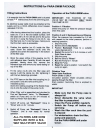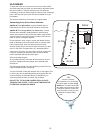UNDERSTANDING YOUR POOL WATER.
Filtered Water. Your pool filtration system has been designed to circulate and filter the whole amount of water within the
pool in approximately 8 hours. This is called ‘the turnover period’. Ideally you should run the filter pump a minimum of 8
hours in every 24.
To achieve this turnover, fitted within the pool wall there is a surface skimmer and a return ‘eyeball’ inlet fitting.
You have a self-priming circulating pump, and a sand filter with multiport valve. Each piece of equipment is described in
detail later.
The surface skimmer is plumbed with pipe work and a control valve to the circulating pump. This takes unfiltered water out
of the pool and under pressure is forced through the sand filter to clean it of small particles, with clean filtered water being
fed back to the pool via the ‘eyeball’ return fitting.
Sanitised and pH Balanced Water. It is vital to bathers health to maintain good wholesome water and to assist the
efficiency of the filtration process. Pool water needs to be kept sanitised and pH balanced. This is to ensure it is kept free
of algae, bacteria and bather pollution.
If left untreated pool water will quickly become algae infested (green), bacteria will build up causing possible infection and
pollutants will make the whole pool very unpleasant.
Disinfection of pool water is carried out to rapidly destroy micro-organisms that may be harmful to bathers health. It is most
important that a residual of sanitiser be maintained in the pool at all times. The most common form of pool sanitiser in use
is stabilised chlorine granules or chlorine tablets (200grm Tri-Chlor Tabs).
The ideal level of chlorine residual to maintain is 1ppm to 2ppm. If the pool is to be heavily used this an be raised to 2ppm
to 3ppm.
The other major consideration in pool water balance is the control of pH.
pH is an acid-alkaline scale, numbered from 0 to 14. Below 7 the water is acidic, above 7 and it is alkaline.
For pool water the ideal pH is between 7.2 and 7.6- if it is lower than 7.2 it will be to acidic and will seriously shorten the life
of your equipment, especially heaters (if fitted) and the pump seal, in addition low pH can cause ‘wrinkles’ in PVC liners.
If the pH is above 7.6 it will be too alkaline, this will cause scale build up on pool liner and reduce the effectiveness of
chlorine- either way this is not good for you, your pool equipment nor the efficiency of other control chemicals.
You will have been provided with and shown how to use the simple chlorine/pH & Alkavis test kit. Regular pool water
testing and adjustment will ensure your pool is ready for use when you are!
Please test your pool water at least twice weekly.
With most domestic pool water test kits supplied (See Fig.2 below) there are two sample cells and three tests - one for pH,
one for chlorine and one for Alkavis (to be dealt with later), the kit is supplied with foil wrapped DPD No1 (for chlorine),
Phenol Red (for pH) and Alkavis (for total alkalinity) Testing Tablets.
TO TEST YOUR POOL WATER -
At the pool side take stopper off of test sample cells, wash out the sample cells with pool water and fill to brim with pool
water. Ideally always take sample from 18” below surface and from the same area of pool, away from the inlet.
Take one Phenol Red test tablet out of foil and place in pH cell, take one DPD No1 test tablet out of foil and place in
Chlorine cell. Replace stopper and shake to dissolve. (Try not to touch the tablet as this will effect the result.)
The water sample will change to a colour of one of the sample colours (hopefully!)- try to match the your colour to a sample
cell colour.
If the chlorine level is low put the filter pump onto continuous and add a chlorine booster tablet via the skimmer or shock
dose, continue to run filter for 24 hours then re-test, if required add stabilised chlorine or a 200grm chlorine tablet to the
skimmer. Return filter to normal pump position. Continue to test regularly.
If the pH reading is high add pH- (Dry Acid). If the pH is low add pH+ (Soda Ash). Generally pH tends to drift high.
(IF CHLORINE LEVEL IS HIGH- I.E. ABOVE 6ppm DON’T SWIM - TAKE CHLORINE TABLET OUT OF SKIMMER
AND/OR WAIT!)
During the swim season it is worth Shock Dosing the pool a after a party or after a thunderstorm, this is done with
unstabilised chlorine such as Shock Chlorine (Calcium Hypochlorite) or Sodium Hypochlorite (Liquid Chlorine).
Should the pool start to go green the same applies, in addition, run the filter pump continuously for 2 - 3 days or until the
water is milky to clear, you may need to add a Clarifier or Floc to the pool to get it clear- (Phone for advice).
,COVERS - SUMMER
To reduce water loss and therefore heat and chemical loss, it is wise to ensure the summer ‘solar bubble’ cover is fitted any
time the pool is not being used. In addition you will enjoy the benefit of any solar gain. The solar cover is placed on the
pool bubble side down!
When the solar cover is removed from the pool always store it in the shade and protect it with the white solar protector
sheet to obtain maximum life from your solar cover.
15


















